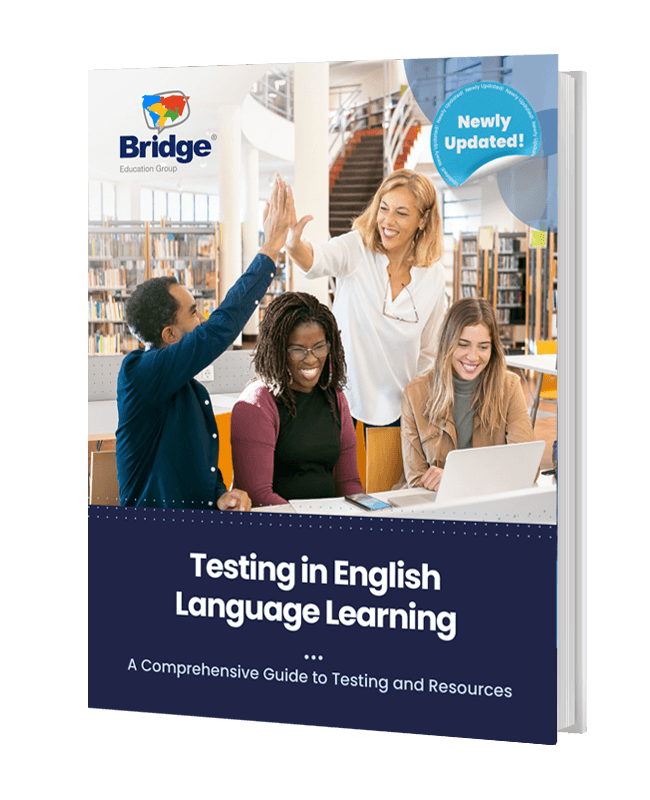A pioneer in language assessment, Bright Language has been a preferred language proficiency assessment provider to organizations around the world for more than 30 years. An early adopter of advancing technologies, Bright Language remains committed to the continued development of testing resources that meet the evolving language assessment needs of educational institutions, multinational companies, and government organizations around the world.
To learn more about Bright Language, we spoke with Cinthia Cristaldi, the organization’s Business Development Consultant.
1. Can you tell me about the types of proficiency tests Bright Language provides?
Bright Language offers the following language assessments:
-
Bright test: The most popular test used by many companies and schools to assess their candidates. It is a listening and written comprehension assessment.
-
BLISS test: A language-speaking assessment that includes an interview with an expert plus a listening and written comprehension module.
-
Writing Solution: A written expression assessment ideal for jobs that require drafting of documents, communications, and reports.
-
Five Star: It is Bright Language’s most comprehensive test. It covers listening and written comprehension plus speaking and written expression.
-
Technical English: This test is specifically tailored for the aeronautic field.
-
Bright Recruitment: A dynamic comprehension test with an optional expression module specially designed for HR and recruitment.
-
Specialized tests: Speaking and written expression assessments tailored for a specific field or domain. These tests can be adapted to cover a particular topic or scenario, providing a more in-depth understanding of the language skills and vocabulary of a candidate applying for a job or for education purposes.
2. How long has Bright Language been in the language assessment industry?
Bright Language is a pioneer in language assessments. It was created more than 30 years ago.
3. What languages can be assessed using Bright Language’s tools?
The Bright test is available in 11 languages: English, French, Spanish, Italian, German, Portuguese, Dutch, Flemish, Swedish, Russian, and Mandarin Chinese.
The expression tests are available in English, French, Spanish, Italian, and German.
4. Who are Bright Language’s typical test takers?
In the academic field, we have candidates who are applying to university to study abroad, students who are required to present an English or French diploma to graduate, or students who are taking language courses at a school, university, or language center.
Our assessments are very popular in the academic sector because they are accessible to everyone everywhere. Students from all over the world can take a recognized and remotely proctored test in secured conditions, without the need to go to a test center or wait for a specific test session that might mean they miss an application deadline.
This has opened the doors of higher and international education for students in communities who weren’t able to travel to a different city or even country to take a test in the past.
In the professional field, the tests are generally taken by candidates applying for a job, by the HR teams for recruitment, by training and development teams to assess their teams after a language training program, or by professionals who need to prove their language proficiency to work abroad or apply for a promotion or internal mobility.
5. What is the format of your language tests?
All the tests are conducted online, on the candidate platform. We have integrated a proctoring tool to ensure the test integrity, the identity of the candidate, and the respect of the exam conditions.
The tests are randomized, with a database of thousands of questions.
The Bright test is a multiple-choice test with 60 questions assessing listening and 60 questions assessing written expression. This module is completed with the expression modules for a more thorough assessment.
6. Can you describe the Five Star test and what makes it different?
The Five Star test is an online language exam that assesses listening, written comprehension and expression, and speaking plus interaction. This test assesses comprehensively grammar, vocabulary, fluency, and syntax. What makes the Five Star assessment different is the fact that the speaking and interaction module is conducted online (via videoconference) in real-time with an examiner, native in the target language. This 20-minute interview allows us to achieve a deeper and more accurate assessment of the candidate’s speaking proficiency, avoiding only prepared monologues without the possibility of asking follow-up questions.
The main purpose of the exam is to be a summative assessment evaluating the skills acquired by a candidate at the end of a language training, or as a diagnostic test, to evaluate their language proficiency at a certain moment.
This exam is suitable for young and adult non-native speakers. All proficiency levels are assessed with this test, from A1 to C1+, and results are correlated with the Common European Framework of Reference (CEFR).
Raise your level of professionalism with
Specialized Certification in Teaching Business English
Get Certified7. What is the structure of the test?
Five Star test structure:
-
An online listening and reading comprehension assessment (approximately 40 minutes). Two modules of 60 questions each, assessing grammar, vocabulary, and structures.
-
A real-time speaking and interaction assessment with a native expert in the target language (20 minutes via M. Teams®). Direct interaction with an expert native speaker, assessing the quality of spoken communication, interaction, vocabulary, comprehension, and spoken fluency.
-
A written expression test (30 minutes) comprising two written composition exercises assessing relevance, clarity, form (grammar), and register (vocabulary).
8. How do Bright Language tests differ from other English language proficiency tests?
For more than three decades, Bright Language tests have been used globally to assess language proficiency, accurately creating new opportunities for growth and mobility for students and professionals from different backgrounds and regions.
The main aspects that make our assessments unique are:
-
Accessibility: Online access to the test from everywhere, with very few technical requirements. Students from all over the world can take a remotely proctored test in secured conditions, without the need to go to a test center.
-
Flexibility: Fast and easy access to the online candidate platforms. No specific test sessions. Registration is fast, and results are available within seven days.
-
Reliability and recognition: A recognized organization that has been developing language tests for decades, recognized and used by hundreds of companies, schools, and universities worldwide.
-
Accuracy: In-depth assessments, with live interviews, human interactions, and supervision to increase the accuracy of our assessments and provide reliable results.
-
Inclusion: Tests adapted to people with special needs.
-
Secured: An efficient proctoring solution to ensure the value and integrity of all tests, for the organization and the candidates. To ensure that the exam conditions are met, the test session is recorded and then verified by our team of experts to guarantee the transparency and accuracy of the results. All data is recorded with the consent of the candidate and is deleted afterward to ensure personal privacy.
9. What kind of feedback do test-takers receive after completing an assessment?
After completing the assessment, candidates receive three kinds of reports. The first is a report with the candidate information, the score, and the level with the Common European Framework of Reference for Languages (CEFR).
A second report shows the mistakes on the comprehension test. For online proctored tests, the candidate will also receive a digitally secured test certificate that can be verified by academic authorities.
10. What role do you see English language proficiency playing in the success of individuals and organizations in the global business environment?
In today’s globalized world, where connection, communication, and mobility are so common and easy, English language proficiency plays a key role in career development, mobility, access to training and higher education, the opening of new markets, the ability to have a broader understanding of different cultures, etc. It is not only important and strategic but is also essential for the success of organizations and the achievement of professional goals and aspirations.
We have an article on our blog about this topic.
11. How does Bright Language ensure that its tests remain up to date with the evolving standards and requirements of English language proficiency?
We are constantly conducting audits and research and requesting feedback from our clients and end users.
At the end of the analysis of these indicators, the development committee develops, if necessary, new areas of improvement relating to:
-
The certification process
-
The content of the tests
-
The evolution of skills and evaluation benchmarks
The mission of this committee is to ensure the adequacy of the certification in relation to the needs of the professional environment. Actions for continuous improvement, monitoring, and development of new tests are part of its objectives. The main actions carried out are as follows:
-
Identification of recruitment, training, and skills needs among corporate clients
-
Developments in skills, professions, and jobs in the field of certifications
-
Competitive analysis of other certifications on the market
-
Carrying out monitoring of educational innovations
-
Carrying out legal and regulatory monitoring
-
Analysis of beneficiaries’ assessments and complaints
-
Analysis of the professional development of candidates, particularly through surveys about stakeholder satisfaction
-
Reflection around new testing or certification projects
Take a deep dive into the spectrum of English language exams and resources with the free guide to
Testing in English Language Learning
Download12. How do you address the varying needs of different sectors (corporations, training organizations, engineering schools) in your testing solutions?
We develop different tests according to each sector’s needs; for example, the new recruitment test is a result of the identification of a specific need after continuous research and exchanges with HR specialists.
13. What future trends do you foresee in language proficiency testing, and how is Bright Language preparing to adapt to these changes?
The first change that we have been seeing in the last years was regarding the accessibility of tests, without compromising the security and test integrity. We have been updating and upgrading our proctoring tool to make our tests accessible for everyone, no matter where they are, and at the same time guaranteeing that the quality of the test and the integrity of the test session remain the same.
Recently, we have developed a new test, Writing Solution 2.0, to answer a growing need of providing tailored tests that can assess a candidate’s language proficiency for a particular field or professional skill.
We are able to develop, along with the client, language assessments that adapt and respond to their field, vocabulary, and specificities for a more efficient and accurate assessment and results.
14. What advice would you give to organizations considering the implementation of English language proficiency tests to enhance their training or educational programs?
One piece of advice would be to start the training with a prepositioning test to have a clear idea of where the candidate’s starting line is. Sometimes there is a gap between the level someone thinks they have and the real skills. This is the reason why our test reports offer a list of “work on points,” based on the questions answered incorrectly, to provide a guideline for the teachers and trainers.
Further advice would be to focus not only on the comprehension skills but also on the expression and interaction, keeping the center of the focus of the training on the human aspect. Also, focus on the training and assessment of competencies, what actions and interactions the candidate will be able to perform with that knowledge, that particular level of proficiency.
15. Is there anything else you’d like to highlight about Bright Language, perhaps any new features or services you are planning to introduce in the near future?
Bright Language assessments are being increasingly used for academic purposes. It is very important for students to train before taking the test, to increase their confidence and performance. The new training platform allows candidates unlimited access for a month, where they can take mock tests and have the corrections to prepare better for the big day. We will soon be releasing a new English-speaking assessment powered by AI. We are very excited about this new tailored test that can be adapted to any field and that will provide a fast and accurate assessment that can also be used as a first interview, so stay tuned!











